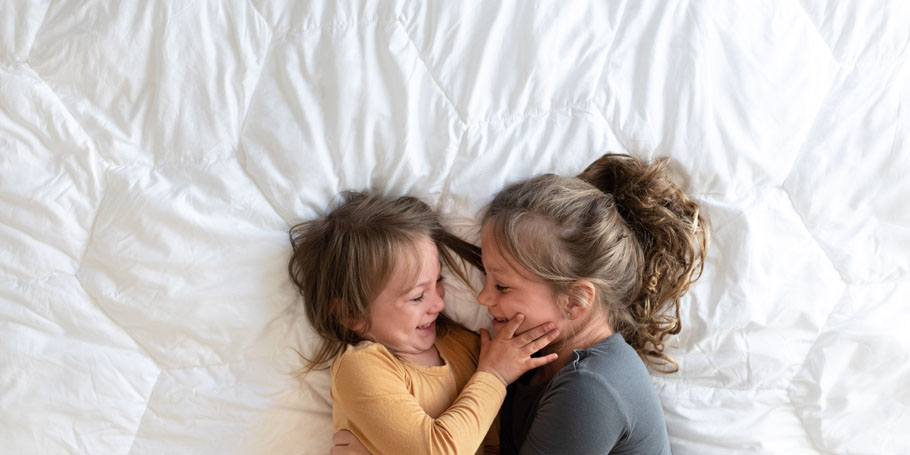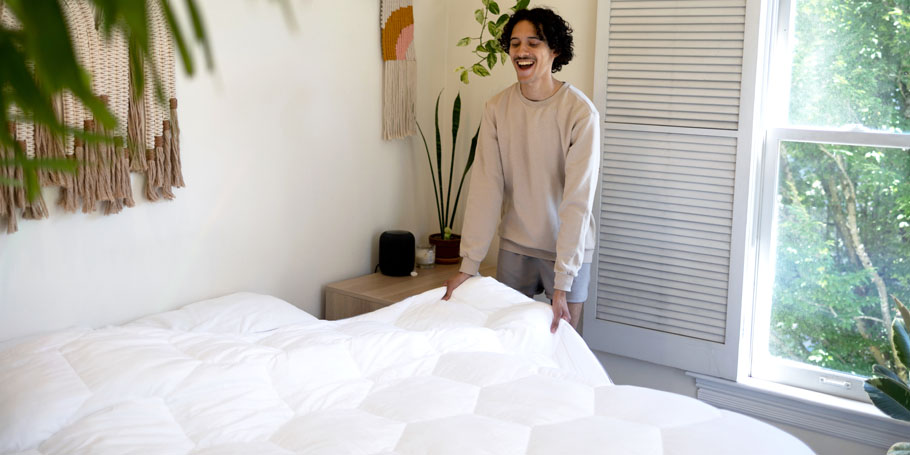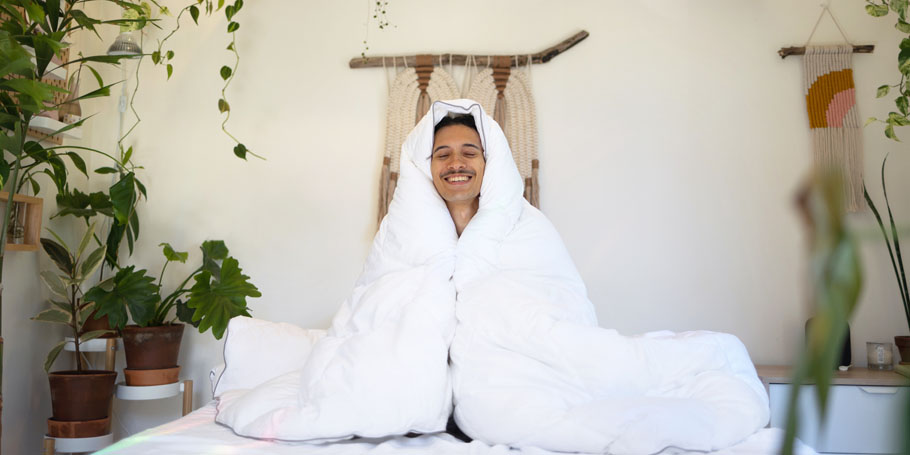In this guide, we’ll walk you through the ideal room temperature for babies, highlight the importance of a suitable temperature, and provide tips to help you keep your baby safe as they sleep. Read from start to finish for a comprehensive overview of baby room temperature or use the links below to skip to the section that interests you.
- The Best Room Temperature for Babies
- The Importance of Temperature for Sleep for Infants
- How to Keep Your Baby’s Room at the Right Temperature
- Tips to Keep Your Baby Safe While They Sleep
- Wrapping Up: Ideal Temperature for Baby Room
The Best Room Temperature for Babies
According to many experts, the best room temperature for sleeping babies falls between 68 to 72 degrees Fahrenheit or 20 to 22 degrees Celsius. Generally speaking, if the room is uncomfortable for an adult, it’s most likely uncomfortable for the baby as well.

Keeping this room temperature in mind is especially important since the risk of sudden infant death syndrome (SIDS) increases when the temperature falls above and below this range. SIDS is when a baby dies without explanation while sleeping, and it’s one of the leading causes of death for infants under one year old.
The Importance of Temperature for Sleep for Infants
The right room temperature can provide several benefits for the overall well-being of your baby, such as:
- Preventing overheating: Overheating can increase the likelihood of SIDS, especially during the winter months when parents may start using a heater, extra layers of clothing, and thicker blankets.
- Promoting deep sleep: When babies are too warm or cold they may toss and turn, reducing the amount of sleep they receive, leading them to become irritable and stressed. A suitable room temperature can ensure they receive plenty of rest.
- Encouraging development: Good sleep can have a significant effect on the mental and physical development of your child, strengthening vital areas of the brain.
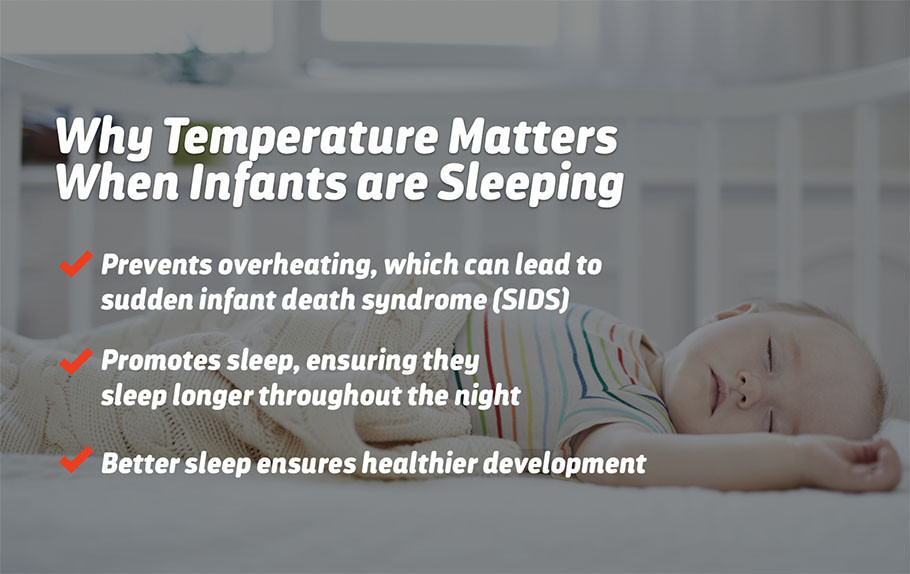
Helping your baby obtain a good night’s rest by regulating a room’s temperature can also benefit you as a parent. A comfortable baby is a baby that’s more likely to sleep through the night and let you get the right amount of sleep.
How to Keep Your Baby’s Room at the Right Temperature
Now that you know the importance of keeping a room at the ideal temperature for a baby to sleep, how can you ensure that it’s maintained within the recommended range? Below, we’ve listed a few simple ways to keep your baby’s room at the right temperature all year long:
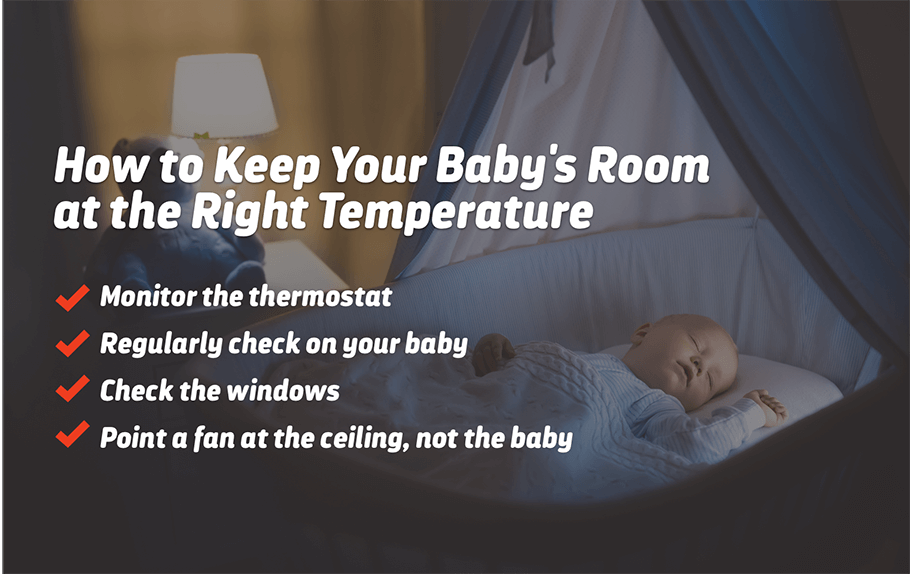
- Monitor your thermostat: To reduce the likelihood of a heartbreaking tragedy occurring, consider keeping a close eye on your thermostat. This way, you monitor the current temperature and make the necessary adjustments whenever it falls out of range. If you don’t have a thermostat in your home, you can use a portable one to determine the temperature of the room.
- Change the direction of your ceiling fan: Depending on the season, you can change the direction of the ceiling fan to fit your needs. For instance, in the summer, you can set the rotation counterclockwise to push cool air down and deliver a breeze. In the winter, allow the fan to spin clockwise to distribute the hot air emitted from the heater through the room.
- Block out the sun: During the day, the sun’s rays can enter through your windows and warm up your room. You can prevent this by using window shades and even blackout curtains.
- Check the insulation: A poorly insulated home can lead to the cold and hot air of your home escaping into the outside world. Proper insulation allows you to sustain an appropriate temperature much easier.
Because of their small size, babies have a harder time regulating their temperature. In fact, babies can lose heat four times more rapidly than adults. So it’s essential to help them out as much as possible by maintaining the ideal temperature for a baby room in summer and winter.
Tips to Keep Your Baby Safe While They Sleep
According to the Centers for Disease Control and Prevention (CDC), about 3,500 babies will experience a sleep-related death. While that number may be alarming, there are many steps you can take to keep your baby safe as they get some Z’s.
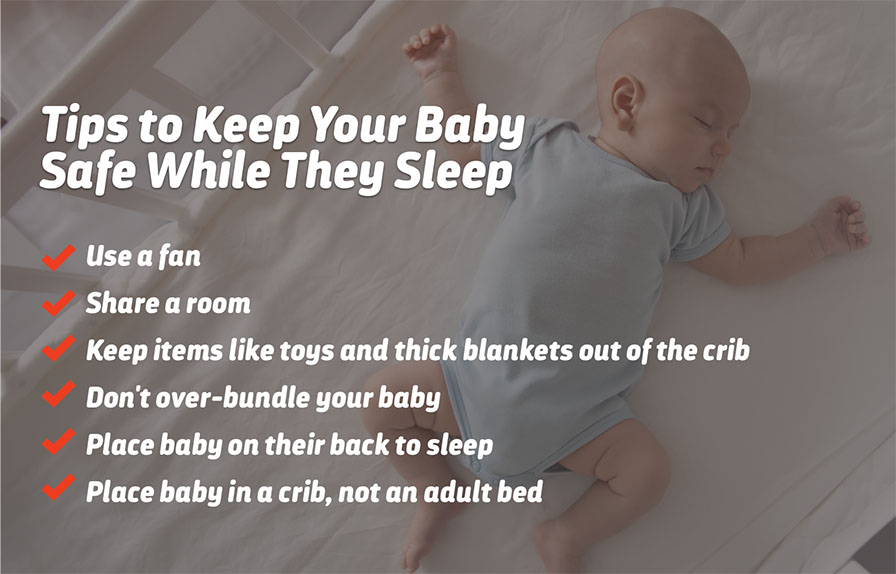
- Use a fan: Placing a fan in your baby’s bedroom will allow air and oxygen to circulate throughout the space. While this may not make the room cooler, it will provide babies with new, fresh air instead of having to re-breathe the same air. However, don’t point the fan directly at your baby.
- Share a room: As a parent, it’s important to keep an eye on your children, especially during the first six months of their lives. The American Academy of Pediatrics (AAP) recommends this to minimize the likelihood of SIDS and allow you to check their temperature throughout the night.
- Keep items like toys and thick blankets out of the crib: To keep your baby cool and safe while they sleep, remove toys, stuffed animals, pillows, and thick blankets out of the crib. Not only can overcrowding their crib increase their temperature, but it can also raise their chances of suffocating.
- Don’t over-bundle your baby: While babies may look cute wrapped in many blankets, over-bundling can cause them to overheat. Added layers on top of an existing fever or when they’re sick could also increase their body temperature.
- Gradually add and remove layers: If you believe your baby is too hot or cold, add and remove layers gradually and continue doing so until they’re comfortable. As far as layers go, use one to two layers for sleeping. However, don’t dress your baby in a hat or beanie during sleep; their face and head help regulate their temperature
- Place the baby on their back to sleep: Although there are several comfortable positions to sleep in, not all of them are suitable for your baby. The best sleeping position for babies is on their back since this allows them to breathe easier and reduces the possibility of suffocation.
- Use a firm mattress: Make sure that the mattress is firm to prevent the fitted sheet or mattress cover from slipping off as the baby moves through the night.
- Place the baby in a crib, not an adult bed: One of the safest places for a baby to sleep is in their own crib or bassinet—even though it’s recommended that you and baby share the same room for the first six months of their lives. Sleeping with your baby in the same bed can lead to overheating and suffocation. Parents can also roll over onto their babies by accident.
- Use lightweight bedding: Sheets for hot sleepers made from bamboo, cotton, linen, and percale don’t trap in body heat, so they’re a great summer bedding option for your baby during warmer months.
You can assess if your baby is overheating by gently touching the back of their neck or stomach as they sleep. If they’re hot to touch or feel sweaty, start removing layers to lower their body temperature. Additional signs of overheating to look out for include rapid breathing, rashes, restlessness, red ears, and flushed cheeks.
On the other hand, you’ll check the same areas plus their chest and back to gauge how cold they are. If they feel cold, but are otherwise doing okay, keep adding one layer until they’re comfortable. Make sure to look for signs of hyperthermia, including constant shivering, slow breathing, pale skin, and dilated pupils.
Wrapping Up: Ideal Temperature for Baby Room
Ensuring you have a baby-safe home is a priority for many parents, which is why it’s essential to know the ideal temperature for a baby room and how to maintain it throughout the year to minizine the risk of SIDS. Here’s what to remember:
- The best room temperature for a baby can range from 68 to 72 degrees Fahrenheit.
- Your baby can’t tell you when they’re hot or cold, so it’s up to you to regularly check on them.
- Retaining the room at a comfortable temperature can prevent babies from overheating, help them sleep better, and boost development.
- You can keep a room at a suitable temperature by monitoring a thermostat and ensuring it’s in the recommended range.
- Besides having the ideal temperature, there are plenty of steps you can take to protect your baby as they sleep.
By taking the information and tips mentioned in this guide, you can help your baby stay comfortable and safe in the right temperature.

